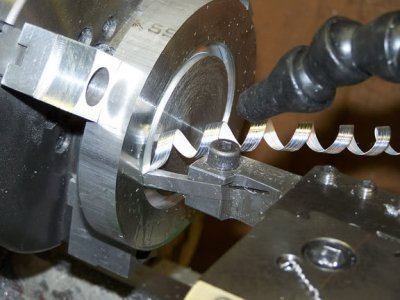- Joined
- Mar 30, 2014
- Messages
- 115
I have a custom little project I am working on. I have a 5-1/4 dia, 1 inch thick aluminum disc I am needing to bore a hole in. I have chucked it up, faced it and drilled a small center hole and started going up till I got to my largest drill bit (3/4). Now I have switched to a boring bar. I went at it for a bit and have gotten it up to about a inch right now. However I need the hole to be 2.75 inches. At the rate I am going with this boring bar, it will take all week to enlarge this hole.
So I was wondering if there is a faster way to bore a large hole on a solid piece of work, on a lathe?
I thought about trying to mark roughly where the hole would be with a marker, leaving my self some wiggle room, then take a regular carbide tipped tool bit, then start at the current center hole and basically make face cuts stopping at the mark I made and then keep doing that over and over till I reach the other side, then finish the the hole with the boring bar. Could that work? I figure I can take slightly larger cuts with a standard tool bit than I can with a boring bar, since the boring bar flexes some if you take too heavy of a cut. Would this be recommended/safe? Or is there a better way?
So I was wondering if there is a faster way to bore a large hole on a solid piece of work, on a lathe?
I thought about trying to mark roughly where the hole would be with a marker, leaving my self some wiggle room, then take a regular carbide tipped tool bit, then start at the current center hole and basically make face cuts stopping at the mark I made and then keep doing that over and over till I reach the other side, then finish the the hole with the boring bar. Could that work? I figure I can take slightly larger cuts with a standard tool bit than I can with a boring bar, since the boring bar flexes some if you take too heavy of a cut. Would this be recommended/safe? Or is there a better way?


